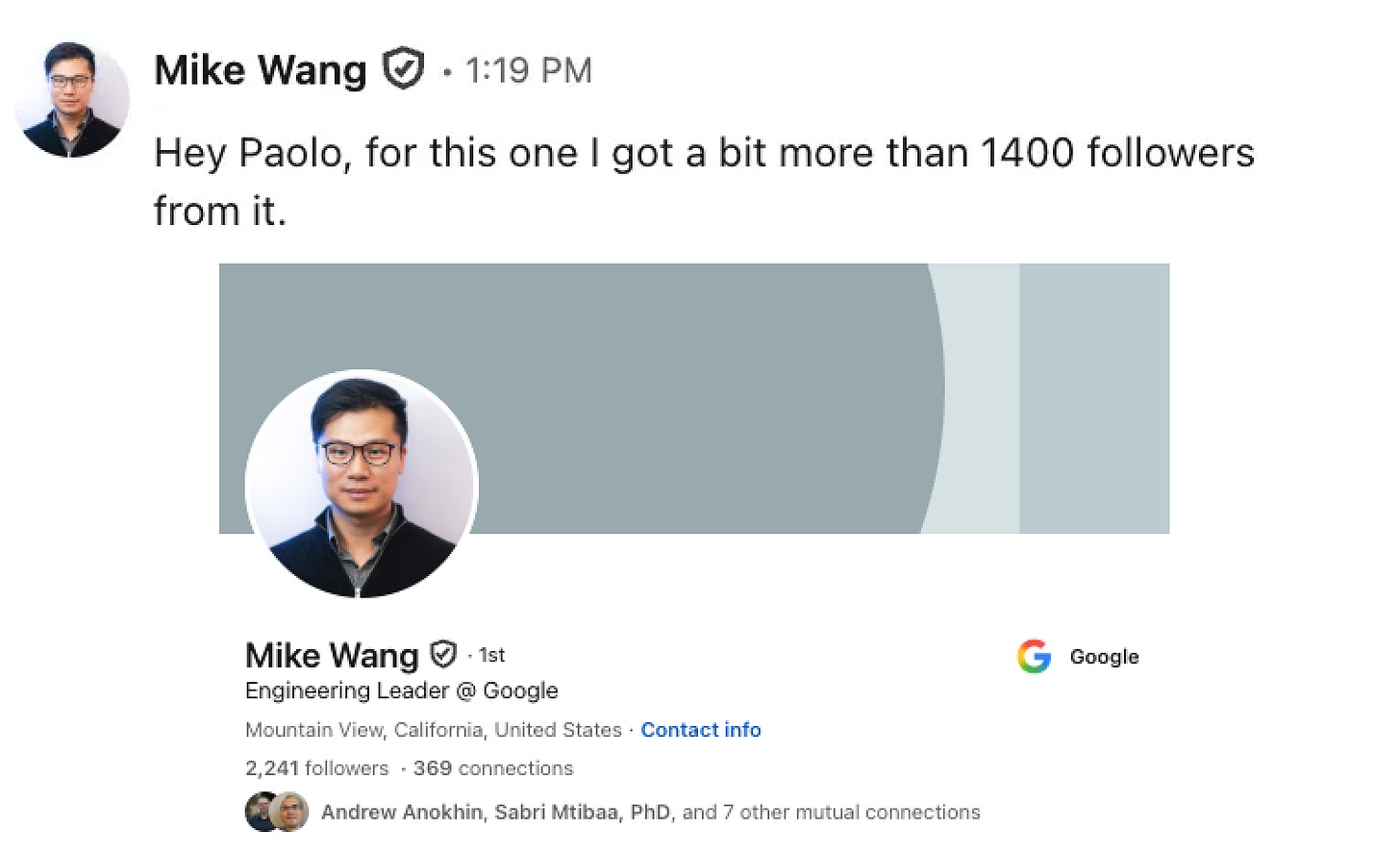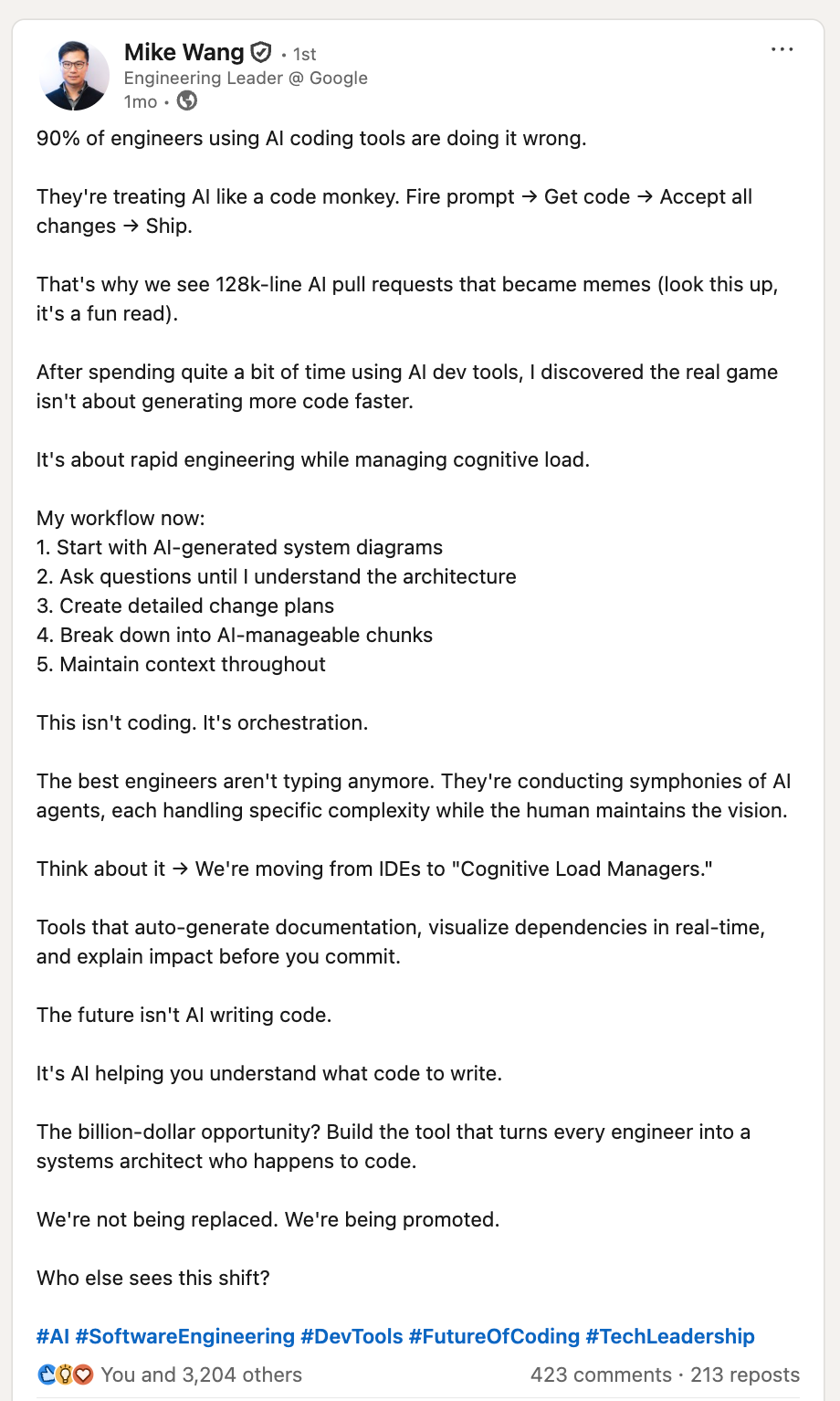Mike Wang just destroyed the biggest myth in content creation.
With 841 followers, he dropped a LinkedIn post that gained him 1,400 new ones. In 48 hours.
That’s 166% audience growth from ONE post.
This proves what I’ve been saying all along: follower count is an excuse, not an advantage.
Every week I hear the same objections:
“Paolo, you have 100K followers, everything you post goes viral.”
“These frameworks only work for big accounts.”
“I need to build an audience first.”
Wrong. Wrong. Wrong.
While accounts with 100K+ followers celebrate 500 likes, Mike transformed 841 followers into 2,241 with a single post.
Let me show you exactly what’s happening in Mike’s post, and why 90% of people trying to replicate it are missing the point entirely.
🎁 Here’s what you’ll get today (free):
The 3 psychological triggers behind the “90% Wrong” framework
The 8-step breakdown of a perfect “90% Wrong” post
The 7-step guide to building your own “90% Wrong” post
3 real examples you can borrow: for Data Scientists, AI Engineers, and Founders
The 5 common mistakes that kill these posts
4 advanced variations to level up:
The “Timeline Levels”,
The “Expert Blindspot”,
The “Industry-Specific Levels”
The “Most People Stop Here”
💎 Paid subscribers also unlock:
The exact prompt that writes the perfect “90% Wrong” posts in seconds
Let’s turn your next post into 1,400 new followers...
🧠 The Psychology of the “90% Wrong” Framework
Here’s what nobody tells you about viral content:
People don’t share insights. They share identity.
When Mike says “90% of engineers using AI coding tools are doing it wrong,” he’s not just sharing an observation.
He’s creating an identity crisis.
And that’s exactly why it works.
The Three Psychological Triggers
1. The Competence Threat
“Am I in the 90%?”
Every engineer reading that hook immediately questions their approach. Not because they doubt AI tools, but because they doubt themselves.
2. The Knowledge Gap
“What do the 10% know that I don’t?”
This isn’t curiosity. It’s FOMO weaponized. The fear of being left behind while others level up.
3. The Tribal Signal
“This person gets the real game.”
By revealing the “deeper truth,” Mike positions himself as an insider who sees what others miss.
🧱 Anatomy of the Perfect “90% Wrong” Post
Let’s dissect why this specific post exploded:
The Hook
90% of engineers using AI coding tools are doing it wrong.Notice what’s NOT there:
No hedge words (”might be,” “probably”)
No softening (”in my opinion”)
No word salads
Just pure, controversial certainty.
But here’s the genius part...
The Relatable Mistake
They’re treating AI like a code monkey. Fire prompt → Get code → Accept all changes → Ship.
That’s why we see 128k-line AI pull requests that became memes.This works because:
Specific behavior everyone recognizes
Visual workflow (the arrows create mental imagery)
Concrete consequence (the 128k-line PR meme)
He’s not attacking people. He’s attacking behavior.
The Paradigm Shift
After spending quite a bit of time using AI dev tools, I discovered the real game isn’t about generating more code faster.
It’s about rapid engineering while managing cognitive load.This is where 80% of people will fail.
They’ll copy the workflow steps but missing what’s actually happening.
Mike didn’t list AI tools or productivity hacks. He revealed philosophy.
“Cognitive load management” reframes the entire conversation.
It’s no longer about being more productive today. It’s about not burning out next month.
The Authority Workflow
My workflow now:
1. Start with AI-generated system diagrams
2. Ask questions until I understand the architecture
3. Create detailed change plans
4. Break down into AI-manageable chunks
5. Maintain context throughoutWhy this works:
Strategic, not tactical (no “click here” instructions)
Progressive complexity (each step builds up)
Implies expertise without bragging
The Identity Transformation
This isn’t coding. It’s orchestration.
The best engineers aren’t typing anymore. They’re conducting symphonies of AI agents.From coder to conductor.
From typist to orchestrator.
This isn’t advice. It’s an identity upgrade.
The Future Vision
Think about it → We’re moving from IDEs to “Cognitive Load Managers.”Coining new categories = thought leadership.
He’s not following trends. He’s naming them.
The Business Hook
The billion-dollar opportunity?
Tools that auto-generate documentation, visualize dependencies in real-time, and explain impact before you commit.This shifts readers from “I need to change how I work” to “There’s a massive gap in the market”.
This transforms his insight into opportunity. Not just personal improvement: industry transformation.
The Reassurance Close
We’re not being replaced. We’re being promoted.After creating identity crisis, he provides identity resolution.
The fear becomes excitement.
The threat becomes opportunity.
🛠️ Building Your Own “90% Wrong” Post
Step 1: Choose Your Target
(30 seconds)
Pick a tool where the obvious use case is 10% of its actual power:
Data tools (AutoML, dbt, Airflow)
AI coding tools (Claude, Cursor, Copilot)
Framework adoption (LangChain, CrewAI)
Step 2: Identify the Surface Behavior
(2 minutes)
What are 90% of people actually doing:
Following tutorials without adapting
Using defaults without optimization
Treating tools as magic instead of leverage
Step 3: Find the Deeper Game
(2 minutes)
Ask yourself:
What’s the real problem they’re solving?
What would an expert do differently?
What’s the strategic advantage they’re missing?
Step 4: Craft Your Opening Hook
(1 minute)
Formula: [Percentage] of [Audience] using [Tool] are doing it wrong.Examples:
“90% of engineers using AI coding tools are doing it wrong”
“90% of data scientists using AutoML are doing it wrong”
“90% of founders using AI for content are doing it wrong”
Step 5: Write the Transformation
(3 minutes)
Structure each section:
The Mistake: What they’re doing (specific behavior + visual description)
The Consequence: Why it fails (relatable pain point)
The Insight: Your realization (time invested + deeper truth)
The Authority: Your approach (5-7 strategic principles)
The Identity Shift: Old way vs. new way (metaphor for transformation)
Step 6: Add the Business Angle
(2 minutes)
Take your insight and show how it creates opportunity:
Tool/solution opportunity: “Current tools fail at Y” → product idea
Market gap identification: “Nobody’s building tools for X” → startup opportunity
Career advancement angle: “Master this = get promoted” → professional growth
Industry transformation vision: “This changes everything” → future prediction
Step 7: Close with Engagement
(30 seconds)
End with a question that:
Assumes they agree with your premise
Invites them to share their experience
Creates community around the new identity
Examples:
“What’s your biggest cognitive load bottleneck?”
“Which engineering myths are you ready to abandon?”
“What would you add to this framework?”
Real Examples You Can Borrow
For Data Scientists:
90% of data scientists using AutoML are doing it wrong.
They’re treating it like a model factory.
Upload data → Click train → Deploy whatever scores highest.
That’s why we see models that work in notebooks but explode in production...
For AI Engineers:
90% of AI engineers using LangChain are doing it wrong.
They’re using it like Lego blocks.
Import chains → Connect components → Ship whatever runs.
That’s why they build systems that break with every prompt variation...For Founders:
90% of founders using AI for content are doing it wrong.
They’re using it like a ghostwriter. Generate post → Light edit → Schedule.
That’s why their LinkedIn sounds like everyone else’s...🚫 Common Mistakes That Kill This Template
1. Being Vague About the Problem
❌ “They’re not using it effectively”
✅ “They’re treating AI like a code monkey”
2. Jumping to Solutions Too Fast
❌ Immediately listing features
✅ First establishing the paradigm shift
3. Making It About Tools, Not Transformation
❌ “Here’s how to use Cursor better”
✅ “You’re not a coder anymore, you’re an orchestrator”
4. Forgetting the Emotional Journey
❌ Problem → Solution → Done
✅ Identity Crisis → Paradigm Shift → Identity Resolution
5. Weak Metaphors
❌ “It’s like using a better tool”
✅ “Conducting symphonies of AI agents”
📈 Advanced Variations
Once you master the basic template, try these:
1. The Expert Blindspot
Focus on what experienced professionals are missing. Shows how even experts can be wrong when paradigms shift.
90% of senior engineers are teaching juniors the wrong approach to AI. They’re passing down pre-AI wisdom...2. The “Most People Stop Here” Framework
Call out exactly where people plateau and why that’s costing them opportunities.
90% of engineers stop at AI code completion.
That’s why they miss the real game: AI as a thinking partner...3. The Timeline Levels
Add urgency by showing what’s coming and when. Creates FOMO for not adapting fast enough.
In 2025, 90% of senior engineers will be orchestrators, not coders. Here’s how to get there first...4. The Industry-Specific Levels
Customize for specific sectors to show deep expertise.
90% of AI engineers in fintech are building the same compliance bottlenecks. Here’s what the top 10% do differently...📋 The Actual Prompt
Keep reading with a 7-day free trial
Subscribe to The Tech Audience Accelerator to keep reading this post and get 7 days of free access to the full post archives.




